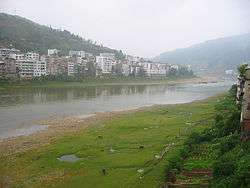Congjiang County
Congjiang County (simplified Chinese: 从江县; traditional Chinese: 從江縣; pinyin: Cóngjiāng xiàn) is a county in Qiandongnan Miao and Dong Autonomous Prefecture, Guizhou, China. It is divided by the Duliu River (都柳江), the upper reaches of the Liu River, and borders Guangxi to the south.
Congjiang County 从江县 | |
|---|---|
County | |
 View of the county seat from along the Duliu River (17 August 2003) | |
 Congjiang is the southernmost division in this map of Qiandongnan | |
.png) Qiandongnan in Guizhou | |
| Coordinates (Congjiang County government): 25°45′15″N 108°54′19″E | |
| Country | People's Republic of China |
| Province | Guizhou |
| Autonomous prefecture | Qiandongnan |
| Area | |
| • Total | 3,244 km2 (1,253 sq mi) |
| Population (2010) | |
| • Total | 290,845 |
| • Density | 90/km2 (230/sq mi) |
| Time zone | UTC+8 (China Standard) |
It is an important transit point as the first county inside Guizhou on China National Highway 321 between Sanjiang (Guangxi) and Guiyang, the provincial capital. A large bridge spans the river and connects the city's two halves.
Languages
In Congjiang County, Miao consists of the following three dialects (Congjiang County Almanac 1999:129).
- Dialectal area 1: parts of Jiajiu Town (加鸠镇); Zhaiping Township (寨坪乡) of Zaibian Town (宰便镇); Shangang (山岗) and Gaodiao (高吊) of Bingmei (丙梅)
- Dialectal area 2: Zaibian (宰便), Xishan (西山) (similar to Rongshui Miao)
- Dialectal area 3: Xiajiang (下江), Tingdong (停洞), Kongming (孔明乡)
Communities
The county seat is known as Congjiang.[1]
The community of Biasha or Basha is within the county. The population are Miao people, and the residents are allowed under the Chinese government to possess and use firearms as this is their cultural heritage.[2] Demonstrations of gun marksmanship and other activities serve as tourist attractions. Katia Andreassi of National Geographic described it as "one of the most visited towns in the area".[3] It is 7.5 kilometres (4.7 mi) from Congjiang town.[1]
Climate
| Climate data for Congjiang (1981−2010) | |||||||||||||
|---|---|---|---|---|---|---|---|---|---|---|---|---|---|
| Month | Jan | Feb | Mar | Apr | May | Jun | Jul | Aug | Sep | Oct | Nov | Dec | Year |
| Record high °C (°F) | 26.6 (79.9) |
30.3 (86.5) |
36.5 (97.7) |
35.7 (96.3) |
36.0 (96.8) |
37.8 (100.0) |
39.2 (102.6) |
38.5 (101.3) |
37.2 (99.0) |
35.8 (96.4) |
31.1 (88.0) |
28.3 (82.9) |
39.2 (102.6) |
| Average high °C (°F) | 11.9 (53.4) |
13.7 (56.7) |
18.1 (64.6) |
24.3 (75.7) |
28.1 (82.6) |
30.7 (87.3) |
32.7 (90.9) |
33.0 (91.4) |
30.4 (86.7) |
24.9 (76.8) |
20.4 (68.7) |
15.1 (59.2) |
23.6 (74.5) |
| Daily mean °C (°F) | 7.9 (46.2) |
9.6 (49.3) |
13.5 (56.3) |
19.2 (66.6) |
23.0 (73.4) |
25.9 (78.6) |
27.5 (81.5) |
27.1 (80.8) |
24.2 (75.6) |
19.5 (67.1) |
14.9 (58.8) |
9.8 (49.6) |
18.5 (65.3) |
| Average low °C (°F) | 5.2 (41.4) |
6.9 (44.4) |
10.3 (50.5) |
15.5 (59.9) |
19.3 (66.7) |
22.5 (72.5) |
23.9 (75.0) |
23.3 (73.9) |
20.3 (68.5) |
16.0 (60.8) |
11.5 (52.7) |
6.4 (43.5) |
15.1 (59.2) |
| Record low °C (°F) | −2.4 (27.7) |
−2.9 (26.8) |
−0.3 (31.5) |
4.6 (40.3) |
8.8 (47.8) |
13.0 (55.4) |
17.1 (62.8) |
17.6 (63.7) |
12.6 (54.7) |
5.1 (41.2) |
1.3 (34.3) |
−3.1 (26.4) |
−3.1 (26.4) |
| Average precipitation mm (inches) | 41.1 (1.62) |
51.4 (2.02) |
67.9 (2.67) |
108.4 (4.27) |
190.7 (7.51) |
210.9 (8.30) |
171.4 (6.75) |
119.3 (4.70) |
76.5 (3.01) |
65.6 (2.58) |
51.6 (2.03) |
31.2 (1.23) |
1,186 (46.69) |
| Average relative humidity (%) | 79 | 79 | 79 | 79 | 81 | 83 | 81 | 82 | 80 | 81 | 80 | 77 | 80 |
| Source: China Meteorological Data Service Center | |||||||||||||
References
- "Picturing the changes among China's last gun tribe". China Daily. Retrieved 27 January 2020.
- "Biasha: The last gunslinger village in China". China.org.cn. Xinhua. 24 July 2014. Retrieved 27 January 2020.
- Andreassi, Katia (July 2013). "Young Gun". National Geographic. Retrieved 27 January 2020. - Click "read more" to view article.
External links